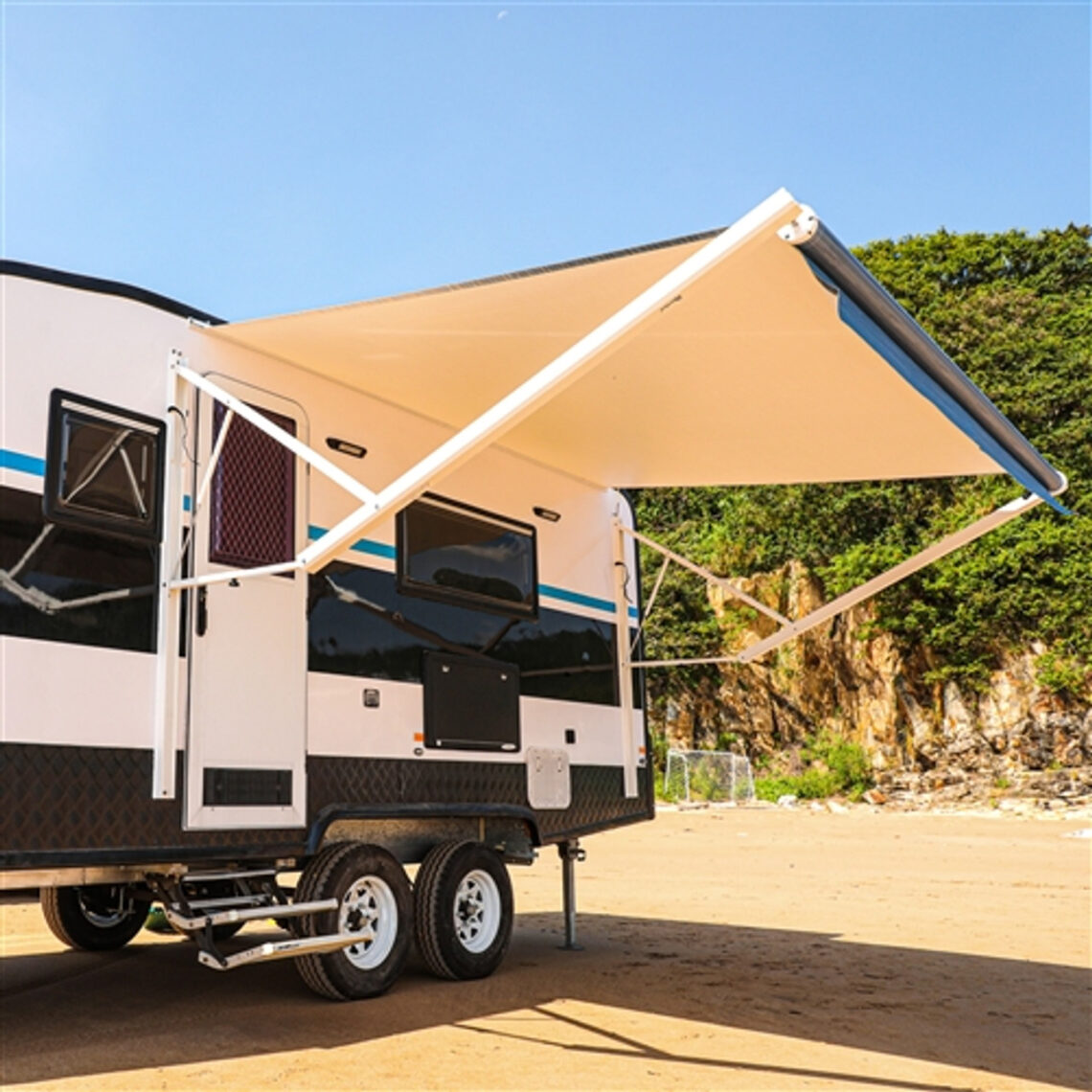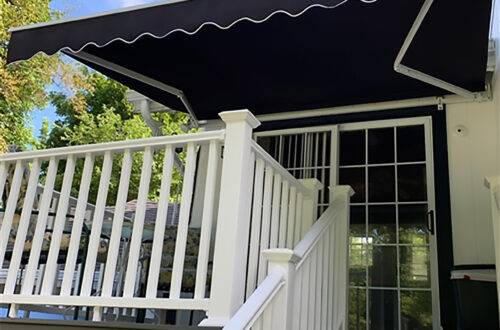Retractable awnings are like the unsung heroes of outdoor comfort, shielding us from the scorching sun or unexpected rain showers with a flick of a switch or a gentle tug. But, alas, even these stalwart defenders of shade and shelter aren’t immune to the occasional hiccup. If you’ve found yourself grappling with retractable awning problems or scratching your head over common RV awning issues, fear not! We’re here to shed some light on the most frequent challenges and equip you with the know-how to tackle them head-on.
Troubleshooting Problems For Home Awnings
Motorized retractable awnings, while simple and reliable, can sometimes throw a curveball your way. Here are some of the most common glitches and how to remedy them.
Stuck Awnings
Picture this: you’re all set to enjoy a lazy afternoon on your patio when your awning refuses to budge. While this situation might seem like a major buzzkill, the solution could be simpler than you think. Here’s how to tackle a stubbornly stuck awning:
- Identify the Culprit: The first step in resolving a stuck awning is to pinpoint the underlying cause. More often than not, this issue stems from dirt, grime, or debris clogging up the tracks. Take a closer look at the tracks along which your awning extends and retracts. Are there any visible obstructions or signs of buildup?
- Clean the Tracks: Need to clean your awning? Armed with a brush, compressed air, or a combination of both, set out to give those tracks a thorough cleaning. Remove any accumulated debris, dust, or dirt that may be impeding the smooth movement of your outdoor awning. Pay special attention to crevices and hard-to-reach areas like the awning brackets where buildup tends to accumulate.
Misaligned Arms
If one of your awning arms is out of sync with the other, it’s like a comedy skit gone wrong. But fear not, for restoring harmony to your awning’s arms might be simpler than you think. Here’s how to tackle this awning issue.
- Inspect for Obstructions: Begin by visually inspecting the path along which your awning arms extend and retract. Look for any obstructions, such as branches, leaves, or other debris, that may be impeding the movement of the misaligned arm.
- Adjust and Lubricate: Once you’ve cleared any obstructions and addressed any damage, it’s time to lubricate and adjust the awning arms. Apply lubricant to the joints and moving parts to ensure smooth operation. If necessary, adjust the tension or alignment of the arms to ensure they move in sync.
Fabric Fiascos
Ah, the heartache of seeing your awning material succumb to tears or mold. But fear not, for there are ways to salvage your beloved awning fabric and restore it to its former glory. Here’s how to tackle common fabric fiascos.
- Patch Up Tears: If your awning fabric has fallen victim to tears or punctures, don’t despair. A patch kit and some adhesive can work wonders in repairing minor damage. Simply clean the affected area, apply the patch according to the manufacturer’s instructions, and allow it to cure completely before use.
- Combat Mold: Moldy awning fabric is not only unsightly but can also pose health risks. To banish those unsightly spots, mix a solution of water and mild detergent and gently scrub the affected areas. Rinse thoroughly and allow the fabric to dry completely in the sun to prevent mold from returning.
By taking proactive steps to address tears and mold, you can prolong the life of your awning fabric and continue to enjoy its shade and shelter for years to come.
Navigating RV Awning Predicaments
RV awnings are the cherry on top of the mobile living experience, providing much-needed shade and shelter wherever your travels take you. However, like any component of your RV, awnings can encounter their fair share of troubles. Here’s how to troubleshoot common RV awning problems and ensure smooth sailing on your adventures.
Weather Conditions
- Wind Woes: Battling the Elements: RV awnings and gusty winds are like oil and water—they just don’t mix. To prevent your awning from turning into a makeshift sail, it’s essential to take proactive measures:
- Retract During Blustery Weather: If wind sensors aren’t an option, make it a habit to retract your awning during periods of high wind. While it may seem inconvenient at the time, it’s a small price to pay compared to the potential damage caused by strong gusts.
- Assess and Repair Damage: In the unfortunate event that your awning sustains damage during a windstorm, don’t delay in assessing the extent of the damage. Inspect the fabric for tears or punctures, and check the awning arms and roller tube for any signs of bending or misalignment. Prompt repairs can prevent further damage and ensure your awning remains in top condition for future adventures.
Electrical Hiccups
For motorized RV awnings, electrical problems can occur, causing frustration and inconvenience. Here’s how to troubleshoot common electrical issues.
- Inspect Wiring: Begin by conducting a thorough inspection of the wiring connected to your motorized awning. Look for any signs of wear, fraying, or damage that could be impeding electrical connectivity. Pay particular attention to areas where wires may come into contact with sharp edges or moving parts.
- Check Power Source: Ensure that the power source supplying electricity to your motorized awning is operational. Check circuit breakers, fuses, and power connections to rule out any issues with the power supply. If you suspect a problem with the power source, consult a professional electrician for further assistance.
- Professional Inspection: If you’ve exhausted troubleshooting steps and are still experiencing electrical issues with your RV awning, it may be time to call in the pros. A qualified RV technician can conduct a comprehensive inspection of your awning’s electrical system, diagnose the problem, and recommend appropriate repairs or replacements.
Mysterious Sags: Addressing Sagging RV Awnings
If your RV awning is sporting a noticeable sag, it’s more than just a cosmetic concern—it could indicate underlying issues with the awning’s structural integrity. Here’s how to tackle this common problem:
- Inspect Roller Tube: Begin by examining the roller tube, the component responsible for extending and retracting the awning fabric. A sagging awning often indicates a stretched-out or damaged roller tube. Look for signs of bending, warping, or excessive wear along the length of the tube.
- Preventative Maintenance: To avoid future sagging issues, incorporate regular maintenance into your RV care routine. Lubricate moving parts, inspect awning components for wear, and address any signs of damage promptly to prolong the lifespan of your awning and prevent costly repairs down the road.
Proactive Measures for Awning Maintenance
Prevention is the name of the game when it comes to awning upkeep. Here are some proactive steps you can take to stave off potential problems:
- Regular Inspections: Make it a habit to inspect your awning for any signs of wear and tear, paying close attention to the fabric, arms, and motor (if applicable). Catching issues early can save you a world of trouble down the line.
- Keep It Clean: Dust, debris, and the occasional bird dropping can wreak havoc on your awning’s performance and appearance. Give it a gentle cleaning with mild soap and water every few months to keep it looking spick and span.
- Mind the Weather: Mother Nature can be unpredictable, so it pays to be vigilant. Retract your awning during strong winds, heavy rain, or snowfall to prevent damage and prolong its lifespan.
By prioritizing safety, you can enjoy your outdoor space with peace of mind, knowing that you’ve taken the necessary precautions to protect yourself and your loved ones.
Wrapping Up
Retractable awnings are a fantastic addition to any outdoor space, providing shade, shelter, and style. While they may encounter the occasional hiccup, armed with the knowledge and tips provided in this guide, you can troubleshoot common problems with confidence. From retractable awning issues to RV awning woes, you now have the tools to tackle any challenge that comes your way.
Remember to stay proactive with maintenance, address issues promptly, and prioritize safety at all times. With a little care and attention, your outdoor awning will continue to enhance your living experience for years to come. So go ahead, bask in the shade, and enjoy the great outdoors to the fullest!
Looking for the perfect awning for your home? Shop our wide selection of outdoor retractable awnings at ALEKO today.






